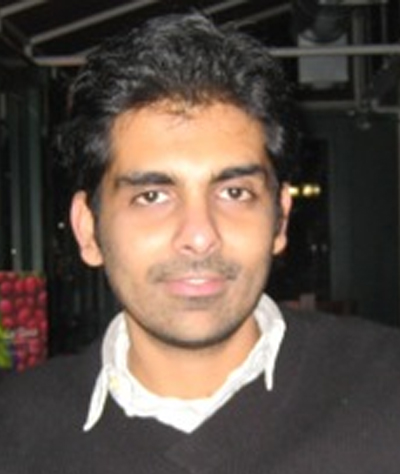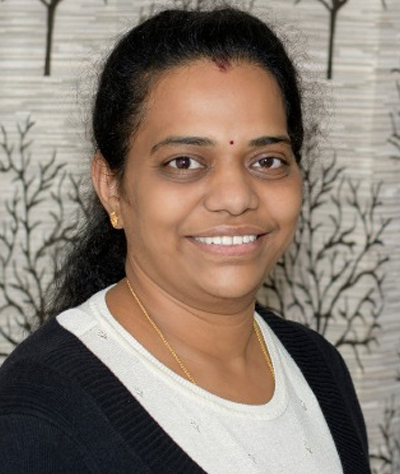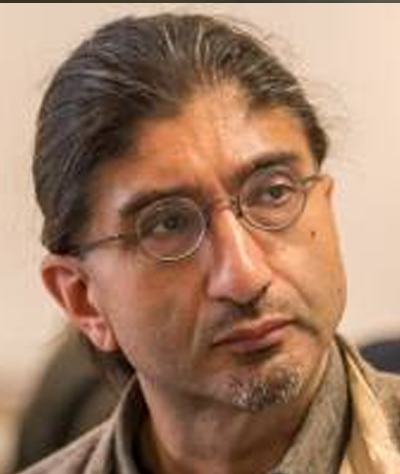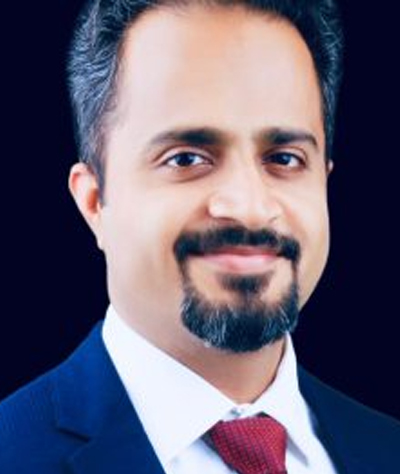Program Day 4 - January 12, 2023

Barani Raman
9:00 - 10:00 :- Conserved signal representation and information processing principles in olfaction
Bio: Barani Raman is an Professor in Department of Biomedical Engineering at Washington University. He received his Bachelor of Engineering in Computer Science with distinction from the University of Madras in 2000, and the M.S. and Ph.D. degrees in Computer Science from Texas A&M University in 2003 and 2005, respectively. From 2006-2010, he was a joint postdoctoral fellow at the National Institutes of Health and the National Institute of Standards and Technology. He is the recipient of the Wolfgang Gopel Award from the International Society for Olfaction and Chemical Sensing, NSF CAREER award, and IEEE Donald G. Fink award. His research interests include sensory and systems neuroscience, sensor-based machine olfaction, machine learning, biomedical intelligent systems, and dynamical systems.
Title: Conserved signal representation and information processing principles in olfaction
Abstract: How information about different sensory cues is represented and what transformations happen to these signals to facilitate different computations are fundamental questions in neuroscience. Whether neural circuits of that process signals of varying sensory modalities and of differing complexities follow a conserved set of principles remains an open question. In this talk, I will first present experimental results characterizing how odorants are received and processed in the locust olfactory system. Then, I will compare these results with observations from fruit flies and mice olfactory systems, and a primate auditory circuit to examine what aspects of signal representation and information are conserved
Session Chair: Hardik J Pandya

Pratik Mutha
10:00 - 11:00 :- To Err is Human, to Learn is Divine – Dissociable error-sensitive mechanisms in human sensorimotor learning
Bio: Pratik Mutha is an Associate Professor in Biological Engineering and the Center for Cognitive and Brain Sciences at IIT Gandhinagar. He received his undergraduate degree from the College of Engineering, Pune and his Masters and PhD from Penn State University in the United States. After a 4-year postdoctoral stint at the New Mexico Veterans Affairs Healthcare System, he joined IIT Gandhinagar in late 2013. Dr. Mutha’s research interests lie in understanding the neural control of human movement. More recent work in his lab is focused on uncovering the neural systems that mediate motor learning, for which he relies on tools of behavioral experimentation, computational modeling, and non-invasive brain stimulation.
Title: To Err is Human, to Learn is Divine – Dissociable error-sensitive mechanisms in human sensorimotor learning
Abstract: Humans must often perform actions under challenging conditions. For instance, a golfer may have to tee off against a constant breeze, or a dancer may have to perform while wearing a heavier-than-usual costume. Such “perturbations” induce a variety of errors in our actions; for instance, they can create a mismatch between the intended and actual sensory consequences of action (sensory prediction error) or result in a failure to accomplish the intended task goal (task performance error). Using a combination of computational modelling and behavioural experiments, we probed how humans adapt future actions when they encounter these two error sources. Our findings fail to support the hypothesis that performance failures induce implicit updates to action plans. They rather indicate that task errors, and possibly, the failure to obtain a rewarding outcome, trigger time-consuming strategic processes that are verbally-sensitive. We also find that sustained task success reduces or eliminates strategy use during learning. In contrast, we note that sensory prediction errors set in motion slower, relatively rigid implicit processes that remain impervious to verbal instruction. We suggest that flexibly combining these two mechanisms could be a way for the sensorimotor system to optimize how much and how rapidly we learn from errors.
Session Chair: Barani Raman

Nivethida Thirugnanasambandam
11:30 - 12:30 - Role of Neural Oscillations in Motor Control – Anecdotal or Causal?
Bio: Dr. Nivethida Thirugnanasambandam has a medical degree from JIPMER Pondicherry followed by a Masters in Biomedical Engineering from IIT Bombay. She then did her PhD in Neuroscience with Prof Michael Nitsche at the University of Goettingen, Germany and a 5-year postdoc with Dr. Mark Hallett at the National Institute of Neurological Disorders and Stroke, NIH, Bethesda, USA. She is currently Assistant Professor at the Department of Biosciences and Bioengineering at IIT Bombay where she leads the Human Motor Neurophysiology and Neuromodulation Lab. Her research focuses on understanding the role of neural oscillations in human motor control and in the pathophysiology of movement disorders, and further employing noninvasive brain stimulation to perturb abnormal behavior.
Title: Role of Neural Oscillations in Motor Control – Anecdotal or Causal?
Abstract: Neural oscillations arise from rhythmic fluctuations of electrical activity generated in the central nervous system either spontaneously or in response to a certain stimulus. There is sufficient evidence to believe that oscillations enable precise coordination of neural processes underlying cognition, memory, perception, and behavior via spectrotemporal synchronization of neural activity within and across brain regions. Motor behavior, like other sensory and cognitive processes, also seems to be associated with specific oscillatory patterns. However, whether such an association is causal or just an epiphenomenon still remains a point of discussion. In this talk, I will introduce neural oscillations and their functional significance in motor control, and discuss how noninvasive brain stimulation studies have added evidence to establish a causal relationship with motor behavior. Further, I will also touch upon the role of ‘pathological’ oscillations in movement disorders with Parkinson’s disease as an example and will finally conclude with proposing noninvasive neuromodulation methods as a potential add-on tool for the treatment of neuropsychiatric disorders.
Session Chair: Barani Raman

Maneesh Sahani
14:00 - 15:30 :- Visualising population dynamics: GPFA and extensions.
Bio: Maneesh Sahani is Professor of Theoretical Neuroscience and Machine Learning at the Gatsby Computational Neuroscience Unit at University College London (UCL). Graduating with a B.S. in physics from Caltech, he stayed to earn his Ph.D. in the Computation and Neural Systems program, supervised by Richard Andersen and John Hopfield. After periods of postdoctoral work at the Gatsby Unit and the University of California, San Francisco, he returned to the faculty at Gatsby in 2004 and was elected to a personal chair at UCL in 2013. His work spans the interface of the fields of machine learning and neuroscience, with particular emphasis on the types of computation achieved within the sensory and motor cortical systems. He has helped to pioneer analytic methods which seek to characterize and visualize the dynamical computational processes that underlie the measured joint activity of populations of neurons. He has also worked on the link between the statistics of the environment and neural computation, machine-learning based signal processing, and neural implementations of Bayesian and approximate inference.
Title: Visualising population dynamics: GPFA and extensions.
Abstract: Individual neurons in the mammalian neocortex do not act alone. Instead, they are embedded within densely interconnected networks, and it is the collective dynamics of these networks which forms the substrate for the rich computational repertoire of the forebrain. Empirical access to these dynamics has historically been challenging, relying on inference either from isolated recordings of individual neurons or from aggregate measures such as local field potentials. Fortunately, the advent of large-scale multiple-neuron recording methods opens the possibility of characterising dynamics directly at the network scale.
I will discuss a family of analytic tools based on Gaussian-Process Factor Analysis, a technique we first introduced in 2009. In particular, I will survey recent updates that incorporate point-process models, time warping, irreversibility and non-linear manifold models into the framework, extending its potential applicability greatly.
Session Chair: Sridharan Devarajan

Shabari Girishan
16:00 - 17:00 :- Can we understand the neural signals controlling the hand movements and reanimate the paralysed hand ?
Bio: Dr Shabari Girishan is a consultant epilepsy & functional neurosurgeon in Bangalore with over 10 years of experience in Neurosurgery. After MBBS and specialising in General surgery from Bangalore Medical College, he secured the M.Ch. degree in Neurosurgery from the prestigious institute of Christian Medical College, Vellore, which is the first centre to start Neurosurgical services in India. He continued to work as an assistant professor for 3 years in CMC, Vellore after which, he worked as a consultant in St.John’s Medical College, Bangalore. During this period he was actively involved in the neurooncology and pediatric neurosurgery practice. He then completed 2 years of fellowship in the subspeciality of Epilepsy & Functional Neurosurgery at All India Institute of Medical Sciences, Delhi, which is ranked as the top medical institute and an institute of national importance under the Central Government ministry of Science and Technology. These fellowships provided a multimodality approach in managing complex epilepsies and movement disorders, head, neck and brain tumours by integrating skills of operative neurosurgery and functional neurosurgery. There are few neurosurgeons in India who can provide both surgical cure for epilepsy and provide relief for movement disorders like Parkinson’s disease by deep brain stimulation and he is one among them. He is a member of various national and international neurosurgical societies, holds academic posts and has many indexed publications and book chapters to his credit.
His areas of interest are Epilepsy surgery, Functional Neurosurgery (Deep Brain Stimulation for Parkinson’s disease, tremors, dystonia), Pain interventions (Spinal Cord Stimulation), Neuro-oncology-brain and spine tumour surgery, Skull base surgery, and Paediatric Neurosurgery.
He is currently pursuing Ph.D. at Indian Institute of Science by working on a project to help patients with irreversible neurological deficits.
Title: Can we understand the neural signals controlling the hand movements and reanimate the paralysed hand ?
Abstract: The technologies for decoding the neural signal are probably replicating along the lines of Moore’s law. However, the clinical translation from these technologies in terms of neurorehabilitation for reanimation of paralyzed hand has been suboptimal. That is, the current technology has not been utilized in full potential for the complete recovery of the human hand dexterity in terms of fine, natural, and more ‘fluidic’ movements. To this day, a totally implantable neuroprosthetic along the line of deep brain stimulation (for Parkinson’s disease) is not available to help patients with cervical spinal cord injuries or stroke. This is because of the various challenges faced at various stages of a neuroprosthetic development, starting from decoding the motor signals to encoding it back to the central nervous structure distal to the level of injury. However, in this review the focus is on the utility of currently available implantable cortical arrays in successfully decoding the motor signals good enough to encode it distally to restore the hand dexterity. The discussion will be focused on addressing some of the important concerns in the context of design aspects of the cortical microarray aiming to address the objective of decoding the motor signals. By this the selection of an appropriate decoding sensor for research and sometime in near future for rehabilitative translation, would become easier.
Session Chair: Hardik J Pandya
